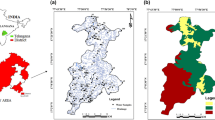Abstract
Groundwater chemistry has been studied to examine the associated hydrogeochemical processes operating for the development of salinity in the groundwater in parts of Guntur district, Andhra Pradesh, India. The study area is underlain by charnockites and granitic gneisses associated with schists of the Precambrian Eastern Ghats. Groundwater is the main resource for irrigation besides drinking. Chemical parameters, pH, EC, TDS, Ca2+, Mg2+, Na+, K+, \( {\text{CO}}^{{{\text{2}} - }}_{{\text{3}}} \), \( {\text{HCO}}^{ - }_{{\text{3}}} \), Cl−, \( {\text{SO}}^{{{\text{2}} - }}_{{\text{4}}} \), \( {\text{NO}}^{ - }_{{\text{3}}} \), F− and SiO2, are taken into account. Groundwater is of brackish type. Na+−Cl− facies dominates the groundwater. Examination of compositional relations and mineral saturation states shows that the ion exchange of Ca2+ for adsorbed Na+, evapotranspiration, dissolution of soil salts, dissolution of NaCl and CaSO4, and precipitation of CaCO3 are the dominant hydrogeochemical processes associated with the groundwater composition in the area. Evapotranspiration causes accumulation of salts in the soil/weathered zone. These salts reach the water table by leaching through infiltrating recharge water. A positive relation between depth to water table and TDS with season supports this inference. The effects of human activities, such as intensive and long-term irrigation, irrigation-return-flow, application of unlimited agricultural fertilizers and recycling of saline groundwater, act to further increase the salinity in the groundwater. Therefore, the groundwater quality increases towards the flow path, while the post-monsoon groundwater shows higher concentrations of TDS, Na+, Mg2+, Cl−, \( {\text{SO}}^{{{\text{2}} - }}_{{\text{4}}} \), \( {\text{NO}}^{ - }_{{\text{3}}} \), F− and SiO2 ions. The study could help to understand the hydrogeochemical characteristics of the aquifer system for taking effective management measures to mitigate the inferior groundwater quality for sustainable development.
Similar content being viewed by others
References
Agrawal, V., & Jagetia, M. (1997). Hydrogeochemical assessment of groundwater quality in Udaipur City, Rajasthan, India. In the proceedings of Dimensions of Environmental Stress in India (151–154), Department of Geology, The Maharaja Sayajirao University of Baroda, Vadodara, India.
APHA (1992). Standard methods for the examination of water and wastewater (p. 326). Washington, DC: American Public Health Association.
Datta, P. S., & Tyagi, S. K. (1996). Major ion chemistry of groundwater in Delhi area: chemical weathering processes and groundwater flow regime. Journal of Geological Society of India, 47, 179–188.
Drever, J. I. (1988). The geochemistry of natural waters (p. 388). New Jersey: Presentice-Hall Inc.
Durvey, V. S., Sharma, L. L., Saini, V. P., & Sharma, B. K. (1991). Handbook on the methodology of water quality assessment. India: Rajasthan Agriculture University.
Fisher, R. S., & Mullican, F. W. (1997). Hydrochemical evolution of sodium-sulfate and sodium-chloride groundwater beneath the Northern Chihuahuan Desert, Trans-Pecos, Texas, USA. Hydrogeology Journal, 5, 14–16.
Freeze, R. A., & Cherry, J. A. (1979). Groundwater (p. 603). New Jersey: Prentice-Hall.
Garrels, R. M., & Christ, C. L. (1965). Solutions, minerals and equilibria (p. 458). New York: Harper and Row.
Hem, J. D. (1991) Study and interpretation of the chemical characteristics of natural water (3rd ed., p. 264). Book 2254. India: Scientific Publishers.
Jankowski, J., & Acworth, R. I. (1997). Impact of debris-flow deposits on hydrogeochemical processes and the development of dry land salinity in the Yass River Catchment, New South Wales, Australia. Hydrogeology Journal, 5, 71–88.
Karanth, K. R. (1997). Groundwater assessment, development and management (p. 720). New Delhi, India: McGraw-Hill.
Khurshid, S. H., Hasan, N., & Zaheeruddin. (2002). Water quality status and environmental hazards in parts of Yamuna-Karwan sub-basin of Aligarh-Mathura district, Uttar Pradesh, India. Journal of Applied Hydrology, XV, 30–37.
Majumdar, D., & Gupta, N. (2000). Nitrate pollution of groundwater and associated human health disorders. Indian Journal of Environmental Health, 42, 28–39.
Meyback, M. (1987). Global chemical weathering of surficial rocks estimated from river-dissolved loads. American Journal of Science, 287, 401–428.
Niranjan Babu, P., Subba Rao, N., Chandra Rao, P., & Prakasa Rao, J. (1997). Groundwater quality and its importance in the land developmental programmes. Indian Journal of Geology, 69, 305–312.
Sarin, M. M., Krishnaswami, S., Dill, K., Somayajulu, B. L. K., & Moore, W. S. (1989). Major ion chemistry of the Ganga-Brahmaputr river system: weathering processes and fluxes to the Bay of Bengal. Geochimica et Cosmochimica Acta, 53, 997–1009.
Sreedevi, P. D. (2004). Groundwater quality of Pageru river basin, Cuddapah district, Andhra Pradesh. Journal of Geological Society of India, 64, 619–636.
Stallard, R. F., & Edmond, J. M. (1983). Geochemistry of the Amazon River—The influence of the geology and weathering environment on the dissolved load. Journal of Geophysical Research, 88, 9671–9688.
Subba Rao, N. (2002). Geochemistry of groundwater in parts of Guntur District, Andhra Pradesh, India. Environmental Geology, 41, 552–562.
Subba Rao, N. (2003a). Groundwater quality: focus on fluoride concentration in rural parts of Guntur District, Andhra Pradesh, India. Hydrological Sciences Journal, 48, 835–847.
Subba Rao, N. (2003b). Groundwater prospecting and management in an agro-based rural environment of crystalline terrain of India. Environmental Geology, 43, 419–431.
Subba Rao, N. (2006). Seasonal variation of groundwater quality in a part of Guntur District, Andhra Pradesh, India. Environmental Geology, 49, 413–429.
Subba Rao, N., & John Devadas, D. (2005). Quality criteria for groundwater use for development of an area. Journal of Applied Geochemistry, 7, 9–23.
Subba Rao, N., Srinivasa Rao, G., Venkateswara Rao, S., Madhusudhana Reddy, P., & John Devadas, D. (1999). Environmental control of groundwater quality in a tribal region of Andhra Pradesh, India. Indian Journal of Geology, 71, 299–304.
Todd, D. K. (1980). Groundwater hydrology (p. 535). New York: Wiley.
United States Laboratory Staff (1954). Diagnosis and improvement of saline and alkali soils (160). United States Department of Agricultural Hand 60, Washington.
Yousaf, M, Ali, O. M., & Rhoades, J. D. (1987). Dispersion of clay from some salt-affected, and land soil aggregates. Soil Science Society of America Journal, 51, 920–924.
Author information
Authors and Affiliations
Corresponding author
Rights and permissions
About this article
Cite this article
Subba Rao, N. Factors controlling the salinity in groundwater in parts of Guntur district, Andhra Pradesh, India. Environ Monit Assess 138, 327–341 (2008). https://doi.org/10.1007/s10661-007-9801-4
Received:
Accepted:
Published:
Issue Date:
DOI: https://doi.org/10.1007/s10661-007-9801-4




